News
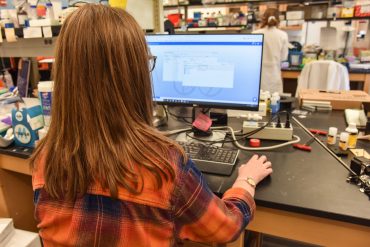
Dec. 3, 2020
Connecting the World Through the Cloud
Maria Lusardi-Claire, an undergraduate student in the Mendoza lab, uses the cloud, a program apart of CyVerse. | photo by Becca Wolf, Bond LSC By Becca Wolf | Bond LSC Clouds come in many shapes and sizes. Some are big and fluffy, others dark and ominous. Or, as in David Mendoza’s case, the cloud is a hub of experiment information. Mendoza, an associate professor of plant sciences and scientist in Bond Life Sciences Center, recently joined the CyVerse, a cyberinfrastructure system used by Mendoza’s lab that acts as and allows his team and collaborators to see data in…
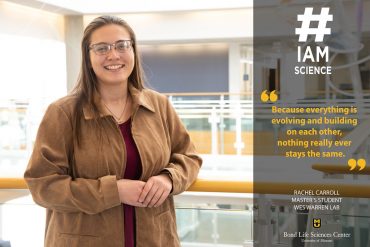
Nov. 20, 2020
#IAmScience Rachel Carroll
By Becca Wolf | Bond LSC Growing up with many pets and watching Animal Planet, Rachel Carroll, a master’s student in the Wes Warren lab at Bond Life Sciences Center, has known one thing about what she wanted to do for a living. “I just decided that I wanted to find a career where I could work with animals,” Carroll said. “As I got older, I realized that there are a lot of things affecting our planet that are causing some of these animals and ecosystems to disappear. These ecosystems are important, and their disappearance really refined my…
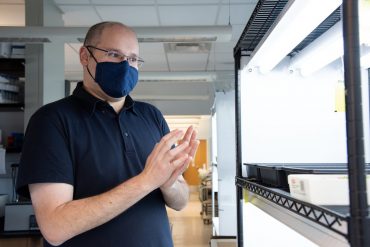
Nov. 17, 2020
Bad Boys of Biology Turned Good
Yosef Fichman, post doctorate fellow in the Mittler lab, walks through how the lab uses arabidopsis plants for certain experiments. | photo by Lauren Hines, Bond LSC. By Lauren Hines | Bond LSC Shaking a bad rap can be hard. However, the Ron Mittler lab at Bond Life Sciences Center has shifted the scientific community’s thinking from seeing reactive oxygen species (ROS) as destructive to vital. “It’s always a challenge when you do something for the first time, and people don’t always believe you,” said Mittler, principal investigator. “They want you to prove it.” ROS are…
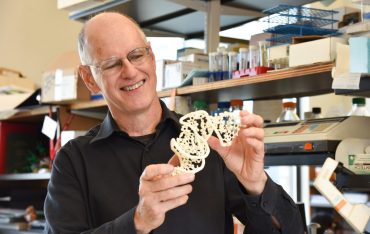
Nov. 9, 2020
Unknown Origins
$5 million grant awarded to study RNA’s place in start of life on Earth In his lab at Bond LSC, Donald Burke-Agüero examines his model of the RNA protein structure. | Photo by Lauren Hines, Bond LSC By Lauren Hines | Bond LSC The search for life on other planets may seem quite literally out of reach, but the search actually starts here, on Earth. “Something that guides people in thinking about how life might come about on other worlds is trying to understand how life might have started here on this planet,” said Donald Burke-Agüero,…
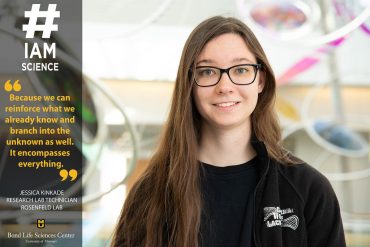
Nov. 6, 2020
#IAmScience Jessica Kinkade
By Becca Wolf | Bond LSC Growing up in Columbia, Jessica Kinkade never thought she would end up working in town. “I never expected to come back here, but it’s neat that it worked out that way,” Kinkade said. “It’s nice to be able to see my family and work in a familiar place that I’ve lived my whole life.” Kinkade went to college about 30 minutes east of MU at Westminster College in Fulton, MO. “I always had an interest in science, especially natural and biological sciences, ever since I was little,” Kinkade said. “I was always…
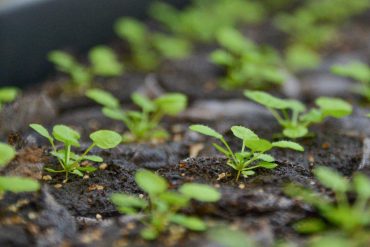
Nov. 5, 2020
Shining Light on Plant Reaction
Arabidopsis grows in Ron Mittler’s lab. | photo by Becca Wolf, Bond LSC By Lauren Hines | Bond LSC Daylight might not seem dangerous, but for plants, too much daylight can cause hazards similar to a nasty sunburn or a human scalding themselves. When you jerk your hand back from a boiling pan or a hot faucet, in a millisecond electrical signals are sent up your arm to tell your brain to move away. Like this reaction, plants have their own protective reactions to too much light. “I think what you need to understand is that plants…
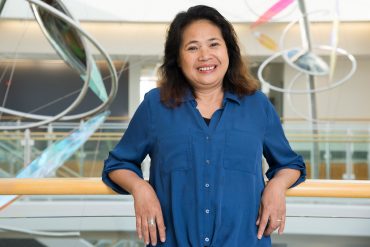
Nov. 2, 2020
Seed size matters: searching for a gene to make a bigger soybean
Bing Stacey | photo by Mariah Cox, Bond LSC By Becca Wolf | Bond LSC Patience is a virtue, at least it is for Bing Stacey. Stacey recently completed a project that took her a total of eight years. It took her five years to develop a fast neutron mutant population and it took an additional three years to screen the population to identify a mutant that showed increase soybean seed size and then identifying the causative gene. This gene, GmKIX8-1, and the seed size QTL, qSW17-1, can potentially be exploited for increasing yield in soybeans. Being able…
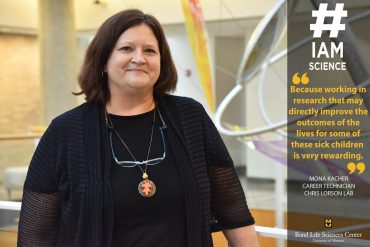
Oct. 30, 2020
#IAmScience Mona Kacher
By Lauren Hines | Bond LSC Years ago, when career technician Mona Kacher was still in school, her science teacher asked their students who wanted to dissect a salamander first. Some students were hesitant, others excited, but no one more excited than Kacher who had already raised her hand. Originally, Kacher was a medical technician in an Army hospital lab. However, when she left the Army, she was encouraged by her then father-in-law to apply for a senior research position at Dalton Cardiovascular Research Center. There, the lab manager asked if she knew anything about…
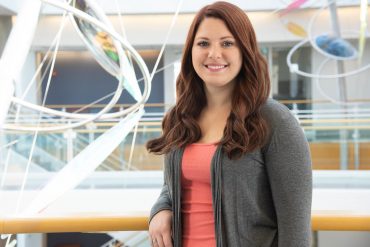
Oct. 28, 2020
Using improved technology to create an Immune Cell Atlas
Ashley Meyer | photo by Mariah Cox, Bond LSC By Becca Wolf | Bond LSC When given an opportunity to use the newest technology, one has to take it. Ashley Meyer, the lab supervisor of the Wes Warren lab at Bond Life Sciences Center, recently started using the improved technology of single cell RNA sequencing to create an Immune Cell Atlas for chickens. This search browser of sorts allows people to search for cells and gene expression in chickens. “It would be a platform for researchers to have a baseline of what should be normal, and then be…
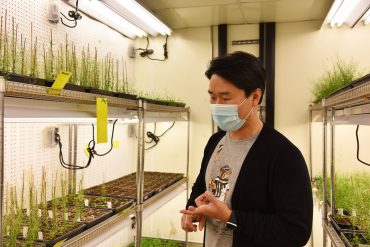
Oct. 26, 2020
Learning From History
Sung-Hwan Cho, a research scientist in the Gary Stacey lab, checks in on the arabidopsis plants that he uses in his purinergic signaling experiments. | photo by Lauren Hines, Bond LSC. By Lauren Hines | Bond LSC Until the 1990s, the presence and significance of extracellular ATP, a nucleotide that normally provides energy to a cell, in animal cells was highly contested for decades. Now, the Gary Stacey lab at Bond Life Sciences Center is using that history lesson to explore ATP’s role in plant cells. Let’s say you have $100 in your pocket. As you’re…
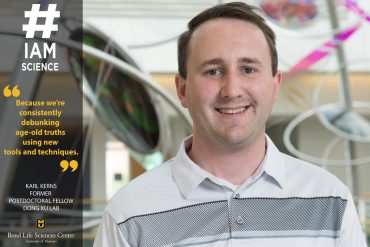
Oct. 23, 2020
#IAmScience Karl Kerns
By Becca Wolf | Bond LSC It’s all about the journey and Karl Kerns has been places. Originally from a small town in southwestern Iowa, Kerns did his undergrad years at Iowa State University (ISU), taking internships in Maryland, Texas, southeast Asia, and southern Australia, among other places that focused on animal physiology and fertilization. “I do like traveling just in the sense of vacation. I like having a purpose while traveling. It’s hard for me to sit back and relax and be in vacation mode,” Kerns said. This focus and determination eventually brought him to Mizzou where…
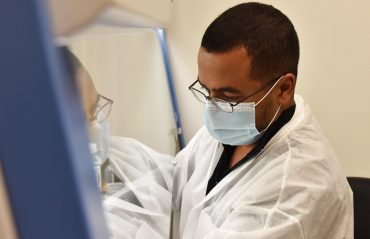
Oct. 19, 2020
Four months in, Baker lab hits the ground running and won’t be stopping anytime soon
Post doctorate Harim Tavares from the Baker lab works in “the hood,” which is a space used to prevent researchers and other outside factors from contaminating cells. By Lauren Hines | Bond LSC Saliva is often something people take for granted. It helps break down food, maintain teeth and keep the oral cavity feeling comfortable. But head and neck cancer patients lose those benefits when chemotherapy treatments damage their salivary glands. Olga Baker set out to research tissue regeneration for these cancer patients by collaborating with the Michael Petris and Gary Weisman labs after setting up…